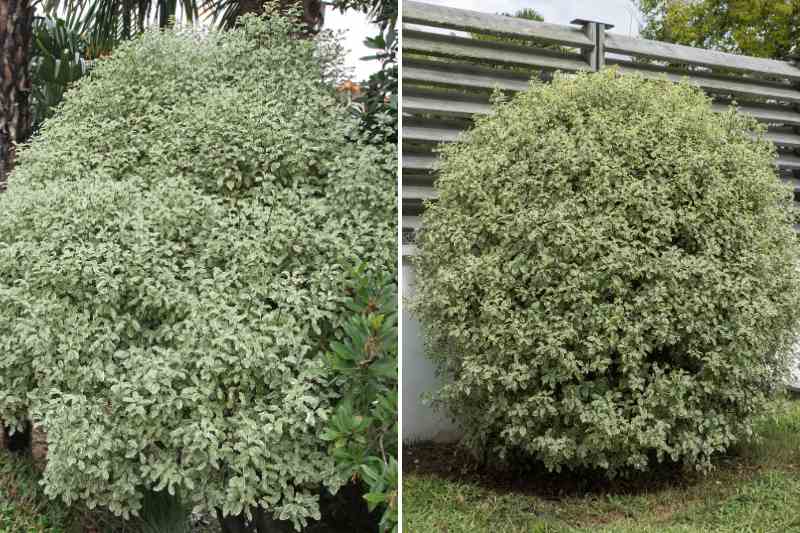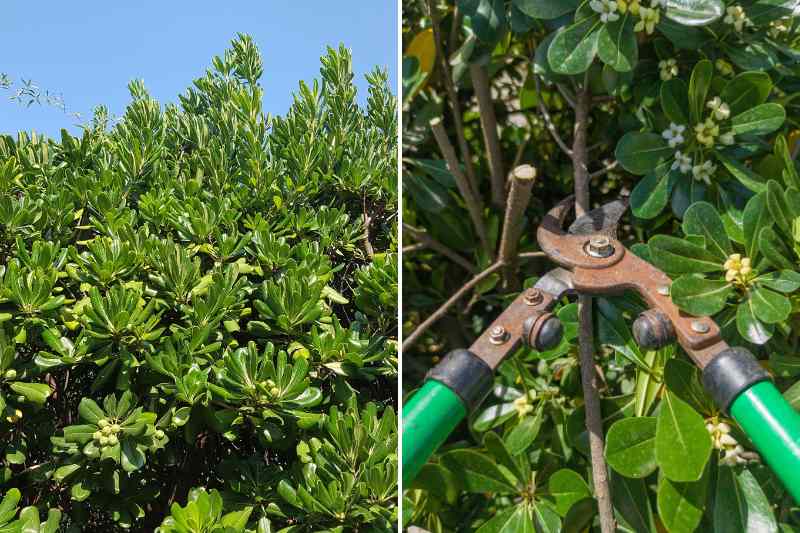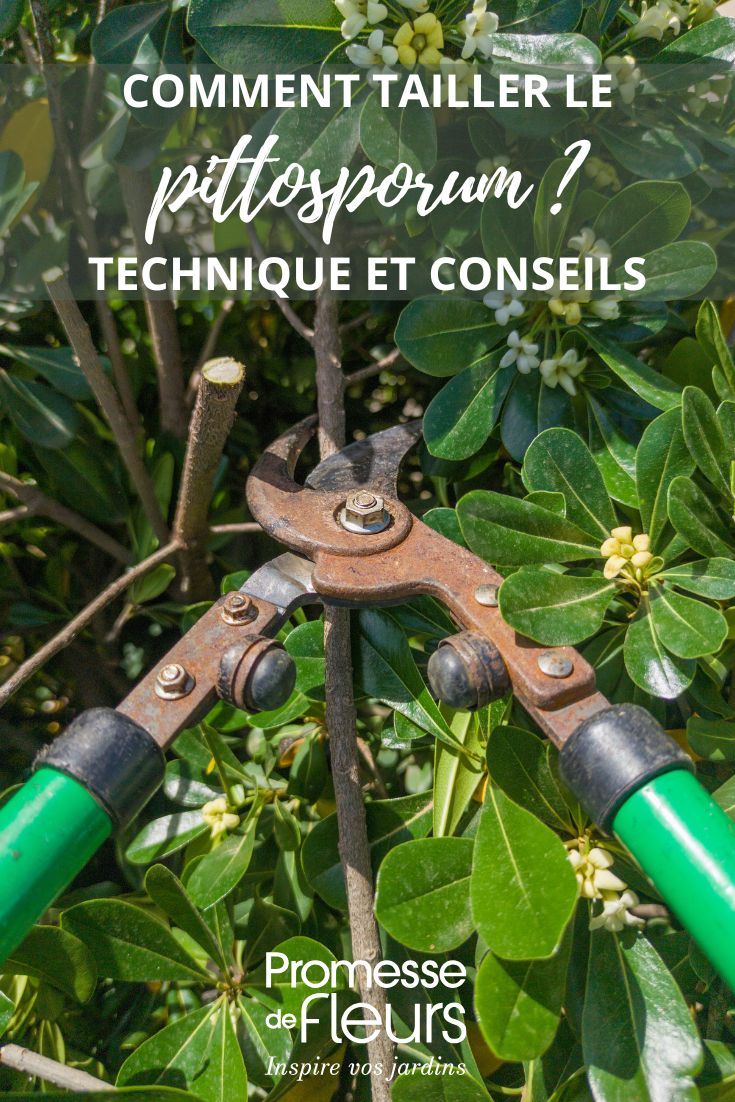The pittosporum is an evergreen bush notable for its dense foliage, glossy and elegant and its discreet yet fragrant spring flowering. Depending on the variety, it can adopt very different habits: the most compact ones, not exceeding 1 metre, are perfectly suited to pot or container cultivation, while the more vigorous ones easily reach 3 to 4 metres in height in open ground, forming superb hedges or structural beds.
Its rapid growth, although moderate in some dwarf varieties, requires regular maintenance, particularly appropriate pruning, to control its development, preserve its harmonious habit and renew the foliage. Without intervention, the pittosporum can quickly become too bulky or lose its beautiful density. Discover when and how to prune your pittosporum with a few simple steps.
Why pruning pittosporum?
Pruning this evergreen bush is not strictly necessary, but it can be done to maintain a harmonious shape and encourage an airy habit. Pruning a pittosporum helps maintain a compact and aesthetic habit, especially if used as a hedge or standalone specimen. It encourages the plant to branch out, which densifies the foliage and gives it a more harmonious appearance. Pruning also helps to limit its development, correct an unbalanced shape or remove damaged or dead branches. The Pittosporum can withstand severe pruning if necessary.

When is the best time to prune Pittosporums?
The ideal time to prune a pittosporum depends on how it is cultivated: as a standalone specimen, in a pot or as a hedge. The basic rule is to avoid pruning in early spring, especially with Pittosporum tobira, as this risks removing the flower buds and compromising the fragrant flowering which occurs between May and June.
For a standalone or potted pittosporum:
- Main pruning: just after flowering, between late June and July, when the plant is still in the growth phase.
- Light maintenance pruning: in August, to refresh the silhouette and remove unbalanced shoots.
For a Pittosporum tobira hedge:
- Minor corrective pruning (optional): between late February and early March, to touch up the tips, correct winter deformations and preserve future flowers.
- Main pruning: in late summer, between August and September, once flowering and the bird nesting period are over. This is the ideal time to reshape the silhouette, rebalance volumes and stimulate dense branching without weakening the bush.
How to prune pittosporum?
Required tools
- Sharp secateurs : for small branches (up to 2 cm in diameter)
- Loppers: for larger shoots
- Hedge trimmer (manual or electric): essential for pittosporum hedges, to achieve a regular and homogeneous cut.
- Gardening gloves
Tip : always clean and disinfect blades before and after use with 70° alcohol or diluted bleach solution.
Steps to properly prune a standalone or free-form pittosporum
- Identify dead, damaged or inward-growing branches.
- Remove dead or diseased wood by cutting cleanly at their base or just above a healthy branch.
- Shorten shoots by about one-third of their length to even out the whole.
- Follow the plant's natural shape or work on a neater structure (it can also be pruned into topiary).
- Make your cuts just above an outward-facing bud to encourage harmonious branching.
- Avoid overly severe pruning on older specimens. Mature pittosporums may take longer to recover : spread the pruning over two seasons to avoid excessive stress.
- Thoroughly clean up pruning debris on the ground to limit disease risks.
Tip: always favour a clean, angled cut just above an outward-facing eye.
How to prune a pittosporum hedge?
Pittosporum tobira is often used as an evergreen hedge, valued for its naturally compact habit and glossy foliage. To keep this hedge well-structured and dense, regular pruning is essential.
- Prune lightly but regularly, to stimulate branching without exhausting the plants. Avoid letting the hedge grow freely for too long, as it may thin out at the base and inside.
- Maintain a slightly trapezoidal shape, i.e., slightly wider at the base than at the top. This allows light to penetrate well to the bottom of the hedge, promoting even density throughout its height.
- Prune from bottom to top, which limits foliage tearing.
- Always prune above a leaf or outward-facing bud, to encourage beautiful branching.
Tips for successful pittosporum pruning
- Avoid pruning in dry, hot weather, as leaves exposed to sunburn may blacken.
- Never perform overly severe pruning, especially on old wood. Pittosporum does not tolerate drastic cutting well and takes time to recover. It's better to do several small annual interventions than one overly heavy pruning.
- Carefully collect pruning debris, which can encourage disease if left on the ground or stuck in the hedge.

Aftercare following pruning
After pruning your pittosporum, a few simple steps will help your bush recover neatly and well-structured:
- Water lightly, especially if the soil is dry or if pruning was somewhat heavy. This helps the plant recover gently.
- Add some well-rotted compost or organic fertiliser around the base to support regrowth without forcing it.
- Mulch the base with bark, wood chips or dry grass clippings to retain moisture, limit weed regrowth and protect the roots.
- Monitor for any signs of stress in the following days: if leaves yellow or a branch shows signs of weakness or drying, don't hesitate to remove them.
- Clean your tools thoroughly after use to avoid disease transmission between plants.
































Comments